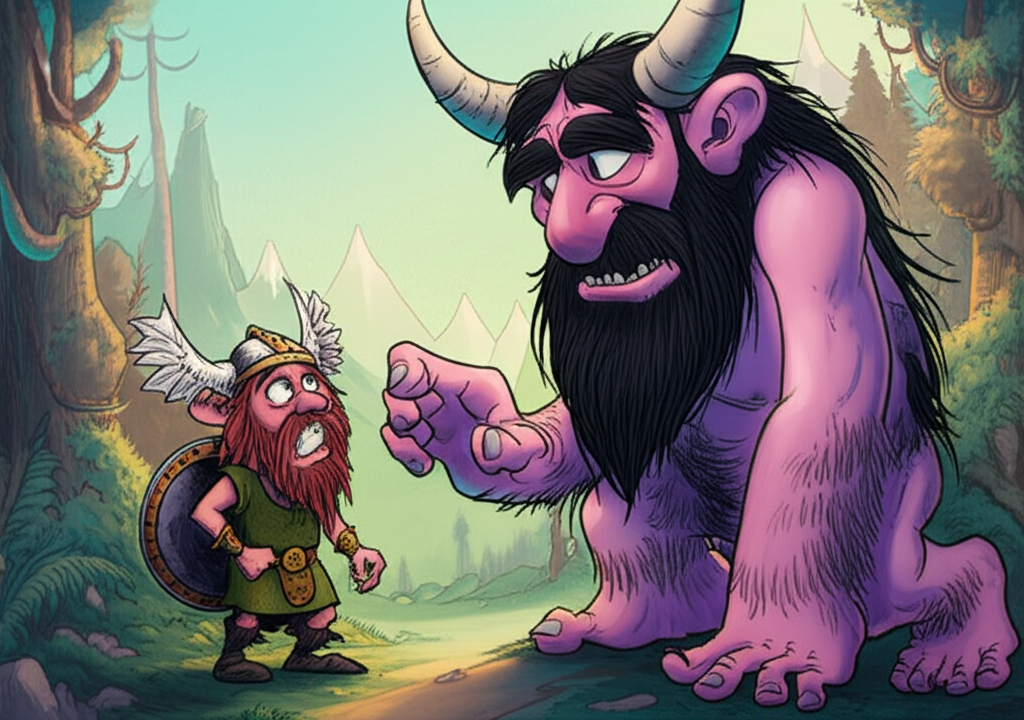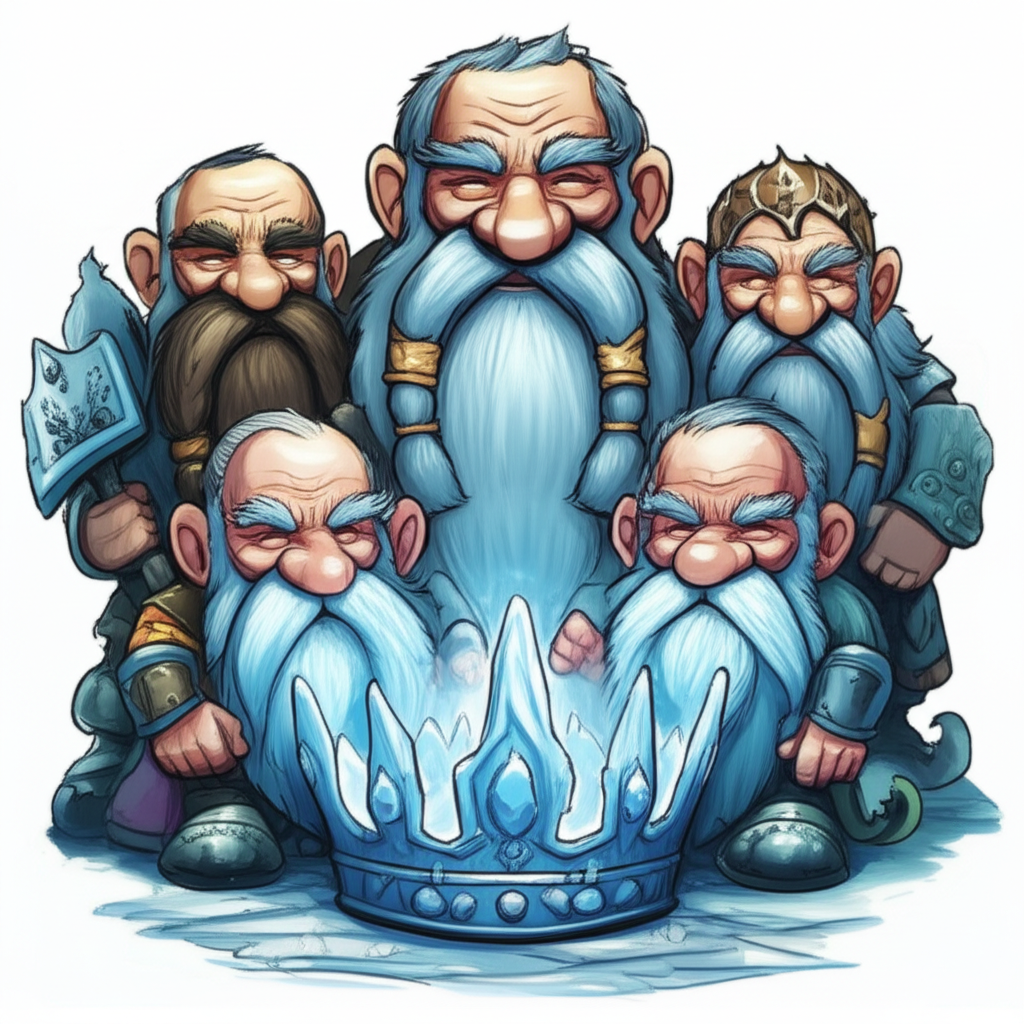Introduction
The story of Bragi, a god of poetry and eloquence, and the binding of the monstrous wolf Fenrir, hails from the icy realms of Norse mythology, a rich tapestry of tales woven by the ancient peoples of Scandinavia. These stories, passed down through generations of oral tradition, were etched into the memories of Skalds (poets) and preserved in the Prose Edda and Poetic Edda, collections of myths and legends compiled centuries after the Norse era. It is crucial to understand that these are traditional stories, shared and cherished by ancient people as a way to understand their world, not as divine truths to be worshipped or followed. They are cultural artifacts, windows into the beliefs, values, and fears of a bygone era.
Origins and Cultural Background
The Norse myths originated in the harsh landscapes of Scandinavia, a region characterized by long, dark winters, vast forests, and turbulent seas. The people, primarily the Vikings, lived in a society deeply connected to nature, where survival depended on the whims of the elements. Their world was populated by powerful gods and goddesses, beings of immense strength and influence who interacted directly with the human realm.
Life was often precarious. The Vikings were skilled seafarers, explorers, and warriors, raiding and trading across vast distances. Their societal structure was hierarchical, with kings, chieftains, and warriors holding positions of power. The world view of these people was profoundly shaped by their environment. They saw the cosmos as a complex system, a struggle between order and chaos, light and darkness, and the constant threat of Ragnarok – the end of the world. They believed in fate, represented by the Norns, female beings who wove the threads of destiny. Death was a constant presence, and the afterlife was a significant focus, with Valhalla, the hall of Odin, being the ultimate reward for warriors who died bravely in battle.
Character / Creature Description
At the heart of our story is Fenrir, a monstrous wolf, one of the three children of the trickster god Loki and the giantess Angrboða. Fenrir was not merely a wolf; he was a symbol of untamed chaos, of the destructive forces that threatened to unravel the order of the cosmos. He was described as a creature of immense size and strength, with jaws that could reach the heavens and the earth. His eyes blazed with primal power, and his very presence radiated an aura of danger. He was a force of nature, a manifestation of the wild and uncontrollable aspects of existence.
Bragi, on the other hand, was a god of a different kind. He was the god of poetry, music, and eloquence. He possessed a silver tongue and a gift for crafting beautiful and persuasive words. He was the embodiment of civilization, of the ability to communicate, to build bridges through language, and to create order through art and storytelling. He represented the power of persuasion, the ability to calm and soothe, and to influence through reason and beauty. His presence in the story represents a contrast to the untamed nature of Fenrir, and highlights the importance of intellect and diplomacy.
Main Story / Narrative Retelling
The gods of Asgard, the home of the Norse deities, knew of a prophecy foretelling that Fenrir would bring about their downfall during Ragnarok. Initially, the wolf was raised among them, but his size and ferocity soon became a concern. They decided to test his strength and, if necessary, bind him.
First, they offered him a mighty chain called Læding. Fenrir, sensing treachery, agreed to be bound, but only if one of the gods would place their hand in his mouth as a guarantee of good faith. Tyr, the god of law and heroic glory, bravely stepped forward, placing his hand in Fenrir’s jaws. The wolf effortlessly broke the chain, proving his immense strength.
Next, the gods presented him with a chain twice as strong, Droma. Fenrir, still suspicious, agreed to the test. He strained and struggled, but the chain snapped once more, proving his power to be even greater than anticipated.
Finally, the gods commissioned the dwarves, skilled craftsmen renowned for their magical creations, to forge a chain of impossible strength. They created Gleipnir, a chain crafted from six impossible things: the sound of a cat’s footfall, the beard of a woman, the roots of a mountain, the sinews of a bear, the breath of a fish, and the spittle of a bird. Gleipnir was as smooth and soft as silk, yet unbelievably strong.
When the gods presented Gleipnir to Fenrir, he was even more wary. He suspected a trick, and refused to be bound unless one of the gods would place their hand in his mouth. Only Tyr, now missing his hand, stepped forward. Fenrir, feeling the subtle embrace of Gleipnir, strained with all his might. The chain held. The other gods laughed at Fenrir’s defeat, but Tyr paid the price of his bravery. Fenrir, in his rage and frustration, bit off Tyr’s hand.
Fenrir was then bound to a rock, and a sword was placed in his jaws to prevent him from biting. He howled in fury and frustration, and his saliva formed a river, the Ván. This binding, however, was not a victory for the gods, but a necessary evil, a temporary measure to delay the inevitable confrontation of Ragnarok.
Symbolism and Meaning
The story of the binding of Fenrir is rich with symbolism. Fenrir himself represents the untamed forces of nature, the destructive potential that lies within the universe, and the inevitable cycle of destruction and renewal. His untamed nature embodies the chaos that constantly threatens to overwhelm order.
The gods, in their attempts to bind Fenrir, represent the struggle to control these chaotic forces, to maintain order and protect themselves from destruction. Their initial failures with Læding and Droma highlight the limitations of brute force and the inherent difficulty in taming untamed power.
Tyr’s sacrifice, the loss of his hand, symbolizes the cost of maintaining order. It represents the need for bravery, sacrifice, and the willingness to pay a price for the greater good. It is a testament to the fact that even in the face of chaos, one must be willing to make sacrifices.
Bragi’s role, though not central to the direct action, speaks of the importance of persuasion and eloquence. The use of the dwarves to create Gleipnir highlights the power of cunning, of skill, and of the ability to use the resources at one’s disposal to achieve a difficult goal. It emphasizes the importance of utilizing intelligence, not just brute strength.
The binding of Fenrir ultimately represents the temporary control of these destructive forces. It acknowledges that chaos cannot be permanently eliminated, only contained, and that the struggle between order and chaos is a continuous one.
Modern Perspective
The story of Fenrir continues to resonate in modern times. It has been reinterpreted in countless works of literature, movies, and video games. The character of Fenrir is often used as a symbol of untamed power, of the dangers of unchecked rage, and the inevitability of destruction. The themes of struggle, sacrifice, and the conflict between order and chaos continue to be relevant to the human experience.
The story has also influenced the development of fantasy worlds and characters. In the popular game "God of War," for example, Fenrir is depicted as a giant wolf, further solidifying the myth’s place in modern popular culture. The tale continues to fascinate, reflecting the enduring human interest in myths and their profound ability to explain the world and its complexities.
Conclusion
The tale of Bragi and the binding of Fenrir is a powerful example of the rich storytelling tradition of the Norse people. It is a cultural artifact, a window into the beliefs and values of a society that lived in close communion with nature and saw the world through a lens of struggle and resilience. It is not meant to be taken as literal truth, but as a symbolic representation of the human experience.
As Muslims, we acknowledge that Allah (SWT) is the one true Creator and Sustainer of all things. We recognize the importance of cultural heritage, of the power of imagination, and of the enduring human need to create stories that explain the world around us. This story, like many others from different cultures, is a testament to the power of storytelling to connect us to the past, to illuminate the present, and to inspire our imaginations. The beauty lies in appreciating the narrative, the symbols, and the cultural context, allowing us to learn and reflect on the diverse ways in which humans have understood the universe throughout history.





